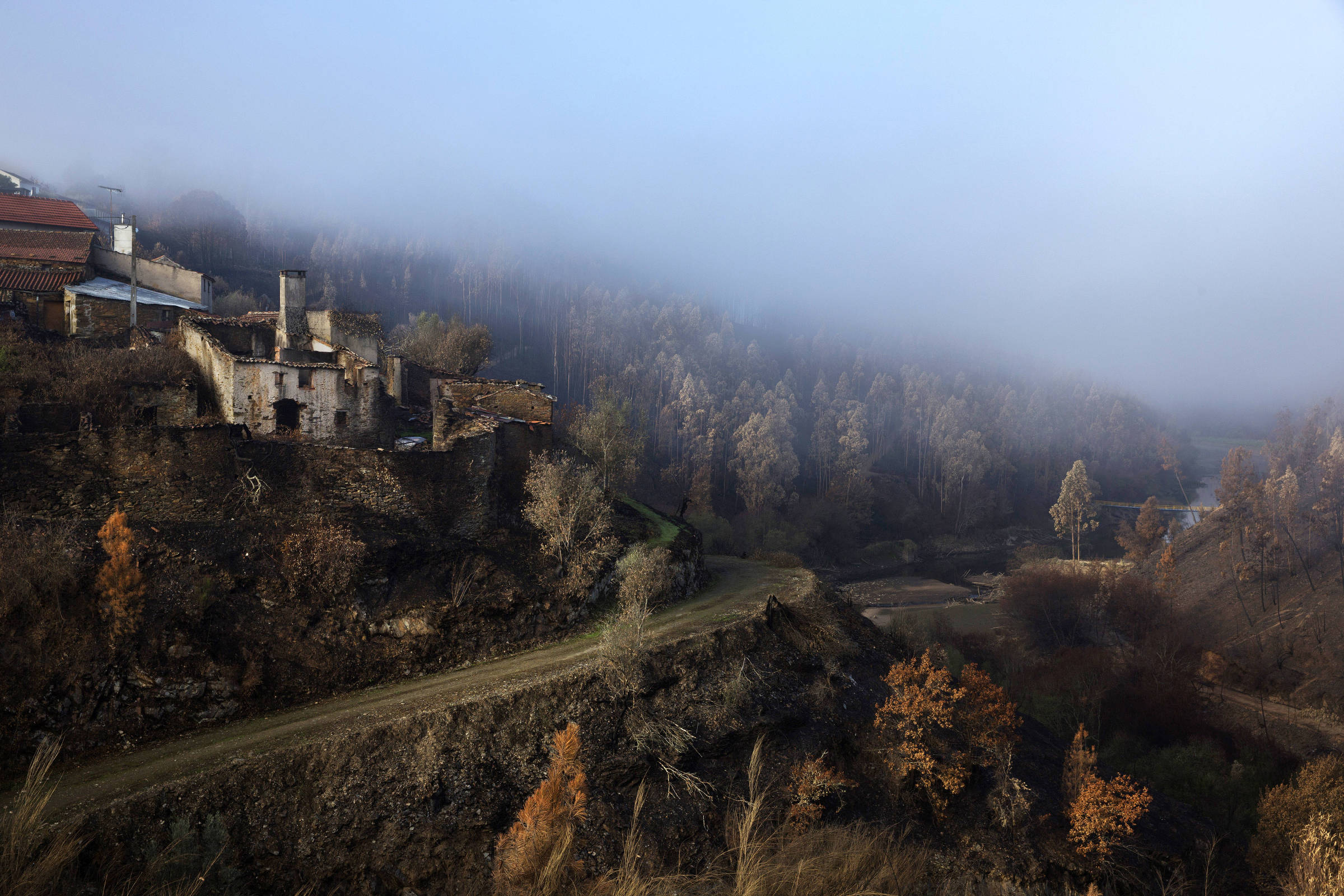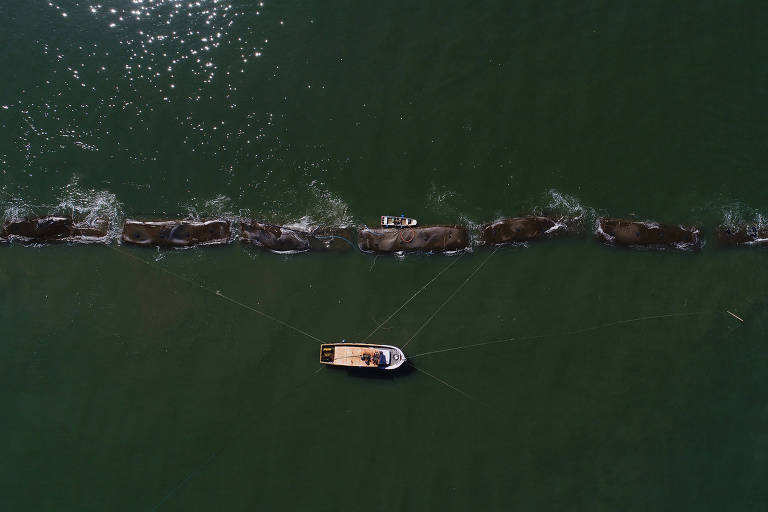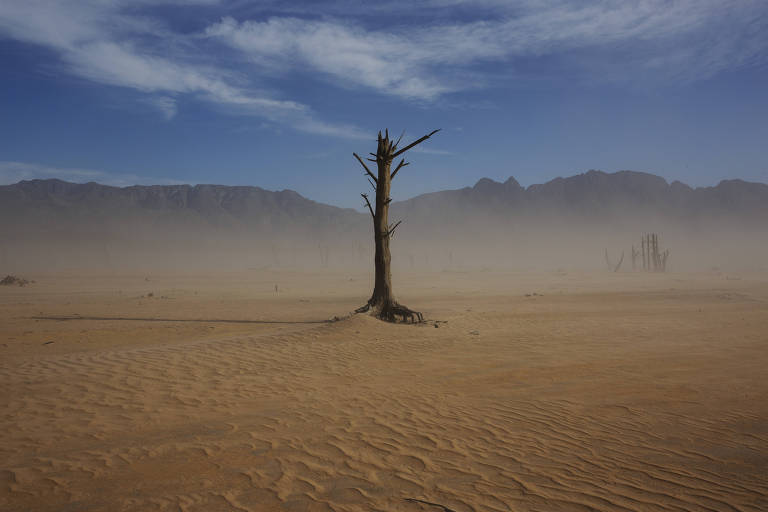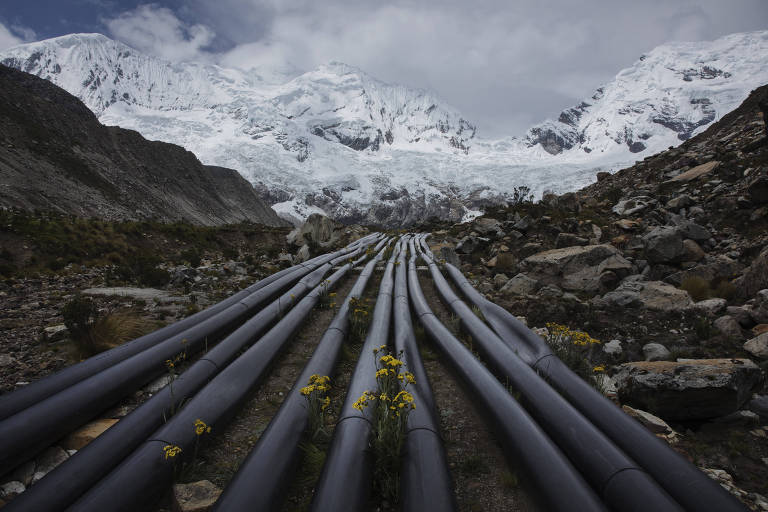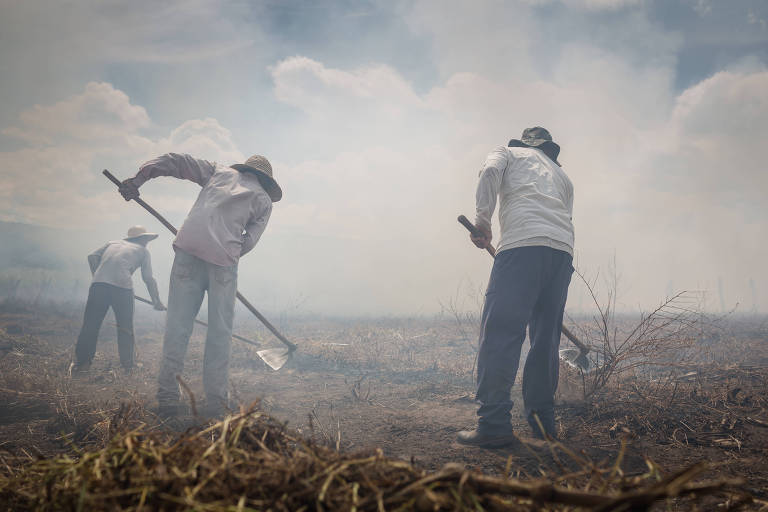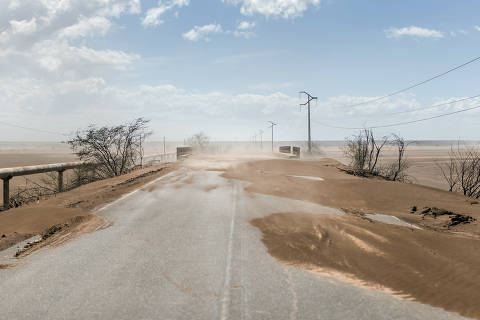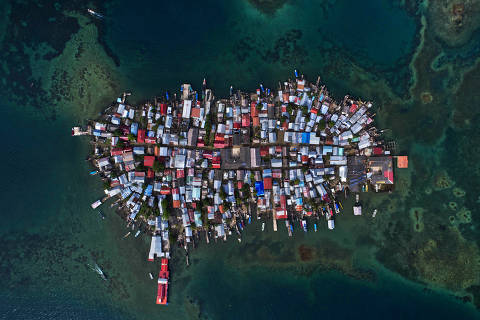Wildfires responsible for 115 deaths in Portugal in 2017
8.mai.2018 - 02h00
{{video=5}}
{{lang=1|por,//arte.folha.uol.com.br/ciencia/2018/crise-do-clima/portugal/|esp,//arte.folha.uol.com.br/ciencia/2018/crisis-del-clima/portugal/}}
António Marques da Costa walks the dirt road every day to collect drinking water for his animals. Along the way, the 74-year-old farmer contemplates everything that was destroyed on October 16, 2017.
It was an unusually hot autumn night when the worst forest fire of the year began. It turned out to be one of the largest in Portugal's history. "I've witnessed other fires," da Costa recalled. "But not like this. The others burned and went out without much trouble."
The conflagration resulted in 49 deaths, adding to the 66 victims of another blaze in June. Many in Portugal have associated these wildfires with global warming, yet most agree that authorities were ill-prepared to deal with the emergencies.
{{imagem=1}}
On one side of the road, a century-old olive tree destroyed by the flames still bears dozens of olives. Consumed by flames just prior to the harvest, the now-desiccated fruit cling feebly to charred branches. The scene repeats itself as far as the eye can see throughout the village of Cerdeira, in central Portugal.
What da Costa witnessed in 2017 has become increasingly common in Portugal and in other parts of the world, such as California. These so-called firestorms are powerful forest fires whose flames are fed under certain weather conditions by drawing in strong currents of air in areas with abundant combustible material.
"The most difficult thing was seeing everything burn that we worked so hard to create," da Costa lamented. "We went back and forth trying to save the house in which I was raised and where my children were living." In addition to more than a hundred olive trees, the farmer lost crops, a grove of chestnut trees and a house where he stored work materials. He says there's no hope of recovering what was consumed by the fire.
"Whatever you have, hold onto it. I can't rebuild the houses. I don't have the money [to rebuild the house and replant the crops]. My pension only pays me 300 euros per month. You can't do anything with that."
{{imagem=2}}
While forest fires are not uncommon in Portugal during the summer months, the scope and severity of the damage in 2017 was unprecedented: 115 people lost their lives and at least 5,000 km2 (roughly 2,000 square miles) of territory was destroyed, more than three times the size of the sprawling megacity of São Paulo. The surprise was that the two major fires occurred in the autumn and spring.
The first fire swept through the area on June 17, a sunny Saturday four days before the start of summer. The blaze left 66 dead in its wake, including nine children. All told, more than 250 people were injured in Pedrógão Grande and Góis, in central Portugal.
Another fire began in the central region on October 16, affecting Oliveira do Hospital, Castelo Branco and surrounding areas, killing 49 people and injuring more than 70 others.
According to Portugal's Secretary of the Interior, Nelson de Souza, the economic toll was 1 billion euros (about $1.2 billion). Indications are that this type of catastrophe could become a more frequent occurrence.
Spain and Portugal have similar climates and weather conditions, yet there are distinct differences in how wildfires are affecting the respective countries. Since the mid-1980s, Spain has seen a marked reduction in the amount of territory affected by fires, while in Portugal there has been almost no change.
{{info=1}}
It is still a stretch to posit a causal link between global warming and the greater numbers of forest fires in Portugal. But climatologist Pedro Miranda believes there are consistent indications of a link. Miranda directs the Dom Luiz Institute, a University of Lisbon center dedicated to meteorology, climate, geophysics and earth sciences research.
"To have a fire, you need a forest," he explains. "And the forest must have the right type of conditions in order for it to burn. And that's it. There just needs to be dry conditions and hot temperatures."
Reduced amounts of rainfall, along with prolonged periods of drought in many years, is one of the primary manifestations of climate change in Portugal. These conditions have become a major contributor to the frequency of wildfires.
"In recent years, we've had several long dry stretches," says Miranda. "In 2003, 2005 and 2017. And the droughts are correlated with periods of more fires."
{{video=3}}
The climatologist points to studies reinforcing a strong relationship between climatic changes and the incidence of forest fires. True confirmation, however, will require more data.
Data from the Portuguese Oceanic and Atmospheric Institute –a government agency– indicate such a confirmation may not be far off. 2017 was an extremely hot and dry year: the average temperature in Portugal was 1,1ºC (2 degrees Fahrenheit) above normal, making it the second-hottest year since 1931. In recent decades, only 1997 was hotter.
{{info=2}}
Construction company owner Verónica Fonseca says that she's living in the flesh what the scientists can only describe in numbers. Her factory was completely destroyed in the October fires, which escaped the forest and reached the industrial zone of Oliveira do Hospital. More than 70 businesses were consumed by the flames.
"I've noticed that it's raining less and less around here," she explains. "For this area, that's not normal. In the past, we've had rain for weeks on end, but that doesn't happen anymore. I don't know if it's because of climate change, but every year there are longer stretches of heat and dry weather," adds Fonseca, who was born and raised in the area.
She stares sadly at the twisted iron remains of the factory her father founded 40 years ago. A dozen or so employees scavenge among the debris and ashes in an effort to salvage items. The charred skeletal remains of pickup trucks are barely recognizable.
"It was as if the fire was flying," she said, remembering the strong winds that fed the flames with more dry air, like a bellows. "We've had forest fires in the past, but none were completely catastrophic."
She estimates her loss at more than 1 million euros ($1.2 million), and complains that the fires in Oliveira do Hospital have received inadequate attention from federal authorities while going mostly unnoticed by the international community.
"When we had the situation in Pedrógão [the June fire that killed 66 people], there was much more news coverage," she said. "Here we didn't get as much. It's probably because more people died there."
{{imagem=4}}
{{mosaico=1}}
{{imagem=7}}
The July 17th wildfires were marked by haunting images along a section of road where the majority of victims perished. Pedrógão Grande is a tourist area known for its river beaches, and there was a large number of people visiting on the day of the fire.
When Folha de S.Paulo visited the site nearly six months after the tragedy, charred trees and street signs were poignant reminders of what happened on route 236, which came to be known as the highway of death.
Like others in the interior of Portugal, Route 236 is a winding road that snakes its way through an area of densely-packed fir and eucalyptus trees –both highly-combustible species.
A report issued by an independent commission investigating the incident found that the sloped terrain in the area contributed to a 67 percent increase of the spread rate of the wildfire (as compared to flames travelling over flat ground).
{{video=4}}
The victims had been using the road as an escape route, but ended up trapped in a 500 meter stretch that became engulfed by flames.
The response to the fires was widely and roundly criticized, particularly the insufficient number of firefighters dispatched to combat the blaze. The majority of firefighters in Portugal are volunteers, with professionals mostly restricted to urban areas.
According to figures compiled by the National Statistics Institute, the number of firefighters has been falling in Portugal. In 2015, the amount of active duty personnel was just under 29,000 firefighters. Ten years ago, there were 42,000. One of the main reasons for this is demographic: there are fewer and fewer people –especially younger residents– living in the interior of the country.
Constança Urbano de Sousa, the Minister of Internal Administration, and Joaquim Leitão, the head of the National Civil Protection Authority, were criticized for lack leadership –and preparedness– during the two wildfires. Both lost their jobs as a result.
{{imagem=8}}
Many calls for emergency assistance were in vain. "I tried to call for help, but communication was impossible," said businesswoman Verónica Fonseca, recalling the night her factory burned down. "The only authorities we saw were the police trying to coordinate, but at some level they were more worried about saving their own lives. It was everyone for themselves."
Luís Miguel Brito, a partner in the Cobral olive oil factory, found himself alone with no one to help him fight the flames that night. The owner of trucks, tractors and some irrigation equipment had to choose between saving his olive plantation or his neighbors' homes. He opted for the neighbors.
"I have close to 75 acres of olive trees and they were totally destroyed," he said. "Both traditional olive groves and older varieties –some more than 100 years old. The quality of olive oil I could produce from those older trees I have now lost forever."
Brito says all signs point to a significant reduction in the amount of olive oil produced in the region. And if the low activity of the local mill used to press olives at harvest is any indication, local farmers indeed incurred significant losses.
{{imagem=16}}
The region of Oliveira do Hospital –which includes the Cobal olive factory– was largely wildfire free for years. This was attributed in large part to sound forest management practices, including clearing of underbrush at regular intervals, which reduces the amount of dry raw material that can fuel flames.
Specialists say these practices are not the norm in other parts of the country, and consider forest management regulations in Portugal to be inadequate. Areas with native species, such as oak and chestnut, are being replanted with pine and eucalyptus, which offer faster financial returns but the species are prone to fire because they form more homogeneous forests of resinous wood that accumulate dry biomass on the forest floor.
There was a 13 percent increase in the amount of eucalyptus in Portugal between 1995 and 2010, according to National Forest Inventory figures. Today, the Australian import dominates Portuguese forests.
"Fires depend on aspects of land use and land management," says climatologist Pedro Miranda. "If our forest didn't have as many combustible trees, it would be more resistant [to wildfires]."
{{info=3}}
In its 2017 state of the environment report, the Portuguese Environment Agency declared that the extreme environmental events that marked the year could be a harbinger of what is to come.
"The majority of the scientific community has signaled that the severe drought, above-average temperatures and the intensification of extreme weather phenomena that we are experiencing in 2017 could be the new reality," the report warns.
João Carlos Mano Castro Loureiro is a professor at the University of Coimbra and coordinator of the Inter-municipal Plan for Adaptation to Climate Change in the Coimbra region –the largest in the country, with 19 municipalities. He says that because the Portuguese forest is concentrated in the hands of small, private land owners, it is even more necessary to develop and implement public policies that encourage the preservation of native species.
{{imagem=15}}
{{imagem=18}}
Loureiro's models indicate that the viability of eucalyptus may be at risk due to higher temperatures, and all of the changes that come with warmer weather. "There are opportunities for our native species, which are much more adapted to this climate," he notes.
The government has promised changes in 2018 to the country's current forest legislation, including the regulation of eucalyptus and other foreign species.
Researchers say it will also be necessary to promote greater public awareness of the new forest reality in the context of climate change. In Portugal, there is a culture and tradition of burning to "clear" the land, much as there is in Brazil.
{{video=2}}
"People have clearcutting ingrained into the yearly routine, notwithstanding the weather [conditions] of that moment," observes Loureiro. "Unfortunately, in last October's fire, this was one of the main reasons people died."
The interdisciplinary report also included survey questions asking people about climate change. Sociologist Fatima Alves, a researcher at the University of Coimbra, notes that few people believe in global warming and its consequences.
"They've heard about climate change in a very broad sense, and they can identify where changes are visible in their daily lives," she says. But this is not enough: "People know something is changing –but let's just say they are not equally committed to changing their own behavior."
{{video=1}}
